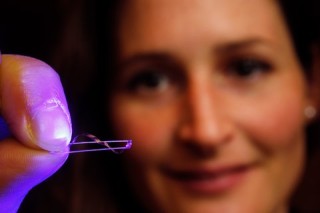Artificial foil undulates under the influence of light
on

Foto: Bart van Overbeeke.
Scientists from TU Eindhoven and Kent State University have developed a material that undulates under the influence of light and can propel itself in this way. They clamped a strip of this new polymer in a rectangular frame and when illuminated the entire assembly takes a walk all by itself. This device, with the dimensions of a paper clip, is the world's first walking machine that converts light into locomotion, simply driven by a single, fixed light source. The researchers have published about this in the scientific magazine Nature.
The maximum speed is about the same as that of a caterpillar, about a half centimeter per second. Remarkable is that the machine crawls into the opposite direction when it is turned over; that is, when the light is pointed to the other side of the foil strip. According to the researchers, in due course, their invention could be used for actuators, very compact transport systems and for maintaining the cleanliness of surfaces such as solar panels. They demonstrate the latter by placing grains of sand on the foil strip, which are subsequently moved off the strip by the undulating motion. This mechanism is so powerful that the foil strip can transport an object that is much bigger and heavier than itself up an incline.
The new material owes its agility to that fact that, under the influence of light, once side contracts and the other side expands. As a consequence it forms a rounded shape when illuminated. The distortion disappears as soon as the light is removed. Although the foil strip appears to be transparent, the material absorbs the violet light that is used almost completely.


Discussion (0 comments)